
 |
|
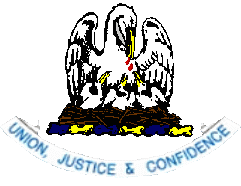













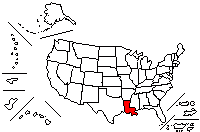
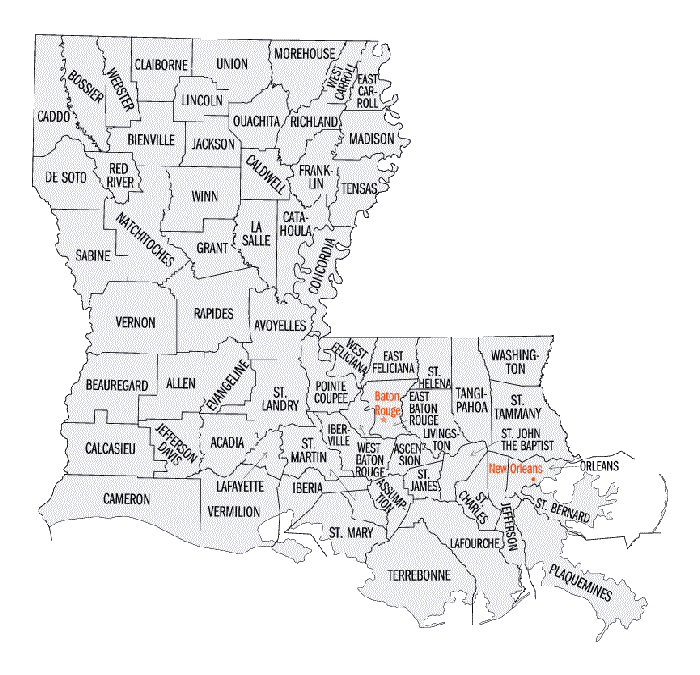

Give Me Louisiana |
Dénme a Luisiana |

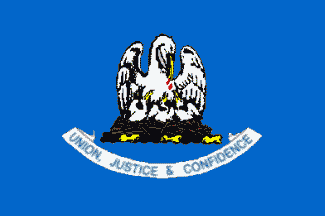
Flag:
"I pledge allegiance to the flag of the state of Louisiana
and to the motto for which it stands:
The design consists of the pelican group from the state seal,
in white and gold, and a white ribbon bearing the state motto,
"Union, Justice, and Confidence", on a field of a solid blue. Flag adopted 1912.
A state, under god, united in purpose and ideals,
confident that justice shall prevail for all of those abiding here."
Bandera: Juro aliancia a la bandera del estado de Louisiana
y al lema por el cual se apoya:
El diseño consiste de un grupo de pelicanos del sello del estado, en blanco y oro y una
cinta blanca con el lema del estado, "Unión, Justicia y Confianza". en un campo de
un azul sólido. La bandera fué adoptada en el 1912
Un Estado, bajo Dios, unido en propósito e ideales, Confiando que la justicia prevalecerá
por todo aquello que perdura aquí".

Louisiana
Capital City: Baton Rouge
National: Louisianans
Admission to Statehood: April 30, 1812
Motto: Union, justice, and confidence
An exact explanation for the choice of
this motto has been lost in time. Clearly, however, it represents the sentiments
present at Louisiana’s joining the Union. Until 1864, the motto had been
“Justice, Union, and Confidence.”
Nickname: Pelican State
Origin of state's name: Named by France in honor of France's King Louis XIV
Louisiana (se pronuncia Lu-i-siá-na en inglés y español)
Ciudad Capital: Baton Rouge
Gentilicio: Luisieños
Admición como estado: 30 de abril de 1812
Lema: Unión, Justicia y Confianza
La explicación exacta de la elección de ese lema se ha perdido con el tiempo. Pero, claramente,
es una representación de los sentimientos presentes en Luisiana al unirse a Los Estados Unidos.
Hasta el 1864, le lema había sido: "Justicia, Unión y Confianza".
Cognómento: Estado del Pelícano
Origen del nombre: Nombre dado por los franceses en honor al rey de Francia Luis XIV.

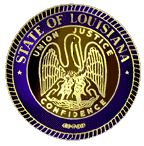
The Seal:
Louisiana's first territorial governor, William C.C. Claiborne had great
admiration for the awkward bird that inhabited the Gulf Coast region.
The pelican, rather than let its young starve, would tear at its own flesh to feed them.
The Governor's great respect for the Pelican led him to first use the bird on official
documents. Many different versions of the present seal, including one with as many as twelve
chicks in the nest, were utilized. Pelicans rarely have more than three chicks in the nest
at any time, and it was a version with three chicks that was officially designed on
April 30, 1902 as the official state seal.
El Sello
El primer gobernador territorial de Luisiana, William C.C. Claiborne
tenía gran admiración por la delicada ave que habitó la región
de la costa del golfo. El pelicano, que antes de dejar a sus polluelos
morir de hambre, se rasgaría de su propia carne para alimentarlos.
El gran respecto del gobernador por el Pelicano lo condujo a primero
utiliza al en documentos oficiales. Muchas diversas versiones
del actual sello, incluyendo uno con tanto como doce polluelos en el
nido, fueron utilizadas. Los Pelicanos tiene raramente más de tres
polluelos en el nido en cualquier momento, y era una versión
con tres polluelos que fue diseñada oficialmente de abril el 30 de
1902 como el sello oficial del estado.

Located in the southeastern United States, Louisiana lies
entirely within the Gulf Coastal Plain. It is shaped like a
capital L, approximately 530 km (330 mi) at its widest, and
about 450 km (280 mi) from north to south. Louisiana is bordered
by Mississippi on the east, the Gulf of Mexico on the south,
Texas on the west, and Arkansas on the north. Sighted by the
Spanish in 1519, Louisiana was first explored by Panfilo de
Narvaez of Spain, who navigated its coast in 1528. Later,
Robert Cavelier, sieur de La Salle, named the region Louisiane
in honor of the French king Louis XIV, claiming it for France
in 1682. The state's long and varied history, diverse population,
abundant energy resources, and strategic location at the mouth of
the Mississippi River are valued attributes. The problems that
exist in Louisiana stem from its prolonged recovery after the
Civil War, its relatively slow industrial growth, and its heavy
dependence on extractive industries.
Permanent European settlement was begun by France almost 200 years
after the Spanish had entered the area. Robert Cavelier, sieur de
La Salle, explored the Mississippi downstream to its mouth, and he
claimed the entire drainage basin for France in 1682. La Salle's
efforts at colonization failed, but the French continued in their
attempt to establish a permanent settlement. Eventually, the colony,
which had also failed at Biloxi, moved upstream on the Mississippi
to the foot of the Great Raft on the Red River, establishing the
first permanent settlement in the Louisiana Territory at Natchitoches
in 1714. Colonization proceeded under the direction of Pierre Le
Moyne, sieur d' Iberville and his brother, Jean Baptiste Le Moyne,
sieur de Bienville.
The early history of the colony is a tragic one, as the first settlers
were ill-suited to the rigors of frontier life. In 1717,
France granted a monopoly on commerce to John Law in order to promote
development of the territory. His Mississippi Scheme was designed to
entice investment in what he claimed was a land of fabulous mineral
wealth. The scheme fell apart in 1720, with no financial rewards to
the investors, but the territory gained population as a result of Law's
promotion.
German peasants from the Upper Rhine area contributed to the
betterment of the region when they began to settle land upstream
from New Orleans in the 1720s. Louisiana became a French crown
colony in 1731. Plantation-grown crops included indigo, rice, and
tobacco; trade was primarily by water, and the few roads ran along
the levees. To this day, the arpent system, based on an old
French unit of measure approximating 0.35 ha (0.85 acres), is
evident in the property lines running back from the streams.
In 1762, Louisiana was ceded to Spain as a result of the French
and Indian War, and Great Britain gained control of Florida,
which extended to the east bank of the Mississippi. At the same
time, Acadians, driven from Nova Scotia by the British, began
migrating to Louisiana. They settled in the eastern prairies
around the present site of Saint Martinville and later along the
Lower Mississippi and Bayou Lafourche.
The Spanish made feeble attempts to offset the growing French
population but were eventually absorbed themselves. In 1800 they
returned Louisiana to France by the Treaty of San Ildefonso.
Although Napoleon I originally intended to establish a new empire
in America, he sold Louisiana to the United States in 1803.
The $15-million Louisiana Purchase represented about 4 cents an acre.
Louisiana became the 18th state on Apr. 30, 1812, comprising the
territory south of 33 degrees North Latitude, which had been the
Territory of Orleans. The rest became the Missouri Territory.
Not until 1819, however, were the Florida Parishes and the lands
west of the Red River added to form the present state boundaries.
During the War of 1812, British ships moved up the Mississippi River
to New Orleans. On Jan. 8, 1815, Gen. Andrew Jackson's troops
defeated the British at New Orleans. The battle ended 15 days after
the Treaty of Ghent was signed, ending the war. Jean Lafitte
aided the American cause.
By 1860 the population exceeded 700,000, and a class system based
on plantations with slave labor had developed. At the same time
yeoman farmers were practicing subsistence farming--Scotch-Irish
in the hills and Acadians in the south. During the Civil War the
importance of the port of New Orleans and Louisiana's strategic
position on the Mississippi made it an early Union target;
the state's economy was devastated.
Louisiana Purchase
In 1762, France had ceded Louisiana to Spain, but by the secret
Treaty of San Ildefonso (1800) the French had regained the area.
Napoleon Bonaparte (the future Emperor Napoleon I) envisioned a
great French empire in the New World, and he hoped to use the
Mississippi Valley as a food and trade center to supply the island
of Hispaniola, which was to be the heart of this empire. First,
however, he had to restore French control of Hispaniola, where
Haitian slaves under Toussaint L'Ouverture had seized power (1801;
see Haiti). In 1802 a large army sent by Napoleon under his
brother-in-law, Charles Leclerc, arrived on the island to suppress
the Haitian rebellion. Despite some military success the French lost
thousands of soldiers, mainly to yellow fever, and Napoleon soon
realized that Hispaniola must be abandoned. Without that island he
had little use for Louisiana. Facing renewed war with Great Britain,
he could not spare troops to defend the territory; he needed funds,
moreover, to support his military ventures in Europe. Accordingly,
in April 1803 he offered to sell Louisiana to the United States.
Concerned about French intentions, President Thomas Jefferson had
already sent James Monroe and Robert R. Livingston to Paris to
negotiate the purchase of a tract of land on the lower Mississippi
or, at least, a guarantee of free navigation on the river.
Surprised and delighted by the French offer of the whole territory,
they immediately negotiated the treaty.
Jefferson was jubilant. At one stroke the United States would double
its size, an enormous tract of land would be open to settlement,
and the free navigation of the Mississippi would be assured.
Although the Constitution did not specifically empower the federal
government to acquire new territory by treaty, Jefferson concluded
that the practical benefits to the nation far outweighed the possible
violation of the Constitution. The Senate concurred with this
decision and voted ratification on Oct. 20, 1803. The Spanish, who
had never given up physical possession of Louisiana to the French,
did so at New Orleans on Nov. 30, 1803. In a second ceremony,
on Dec. 20, 1803, the French turned Louisiana over to the United
States. Disputes with Britain and Spain over the boundaries of the
purchase took years to resolve.
Localizado en los Estados Unidos del sudeste, Luisiana se encuentra
enteramente dentro del llano costero del golfo. Su forma es como una L
mayúscula, aproximadamente 530 kilómetros (330 millas) en su parte más
ancha, y cerca de 450 kilómetros (280 millas) del norte al sur.
Luisiana es rodeada por Mississippi en el este, el golfo de México
en el sur, Texas en el oeste, y Arkansas en el norte. Avistado por
los españoles en 1519, Luisiana primero fue explorada por Panfilo de
Narvaez de España, que navegó su costa en 1528. Más adelante,
Robert Cavelier, sieur de La Salle, nombró la región Louisiane en
el honor del rey francés Louis XIV, demandándola para Francia en
1682. La historia larga y variada del estado, la población diversa,
los recursos energéticos abundantes, y la localización estratégica
en la boca del río de Mississippi son cualidades valoradas. Los
problemas que existen en Luisiana provienen su recuperación
prolongada después de la guerra civil, su crecimiento industrial
relativamente lento, y su dependencia pesada de industrias
extractivas.
El establecimiento europeo permanente casi fue comenzado por Francia
200 años después de que los españoles hubiesen entrado en el área.
Robert Cavelier, sieur de La Salle, exploró el Mississippi río
abajo, y él demandó la desembocadura del río completamente para
Francia en 1682. Los esfuerzos de La Salle en la colonización
fallaron, pero los franceses continuaron en su tentativa de establecer
un establecimiento permanente. Eventual, la colonia, que también
había fallado en Biloxi, se movió contra la corriente en el
Mississippi al pie de la gran balsa en el río rojo, surgiendo el
primer establecimiento permanente en el territorio de Luisiana en
Natchitoches en 1714. La colonización procedió bajo dirección de
Pierre Le Moyne, sieur d ' Iberville y su hermano, Jean Baptiste Le
Moyne, sieur de Bienville.
La historia temprana de la colonia es trágica, como los primeros
colonos eran impropios a los rigores de la vida de la frontera. En
1717, Francia concedió un monopolio en comercio a la "John Law" para
promover el desarrollo del territorio. Su esquema de Mississippi fue
diseñado para tentar la inversión en lo que él demandó era una
tierra de la abundancia mineral fabulosa. El esquema bajó aparte en
1720, sin recompensas financieras a los inversionistas, pero el
territorio ganó a la población como resultado de la promoción de la
ley.
Los campesinos alemanes del área del Alto Rhine contribuida a la
mejora de la región cuando comenzaron a colocar la tierra contra la
corriente de New Orleans en el 1720s. Luisiana hicieron una colonia
francesa de la corona en 1731. las cosechas
incluyeron el añil, el arroz, y el tabaco; el comercio estaba sobre
todo al lado de agua, y los pocos caminos funcionaron a lo largo de
los diques. A estos días, el sistema arpent, basado en una vieja
unidad de la medida francesa que aproxima 0,35 has (0,85 acres), es
evidente en las líneas de la característica que funcionan detrás de
las corrientes. En 1762, Luisiana fue cedida a España como resultado
de la guerra francesa e india, y gran Gran Bretaña ganó el control
de la Florida, que extendió al banco del este del Mississippi. En el
mismo tiempo, Acadianos, conducido de Nueva Escocia por los
Británicos, comenzó a emigrar a Luisiana. Colocaron en a lo largo
las praderas del este alrededor del actual sitio de Santo Martinville
y más adelante Bajo Mississippi y Bayou Lafourche.
Débiles tentativas españolas fueron hechas para contrarrestar la creciente
población
francesa, pero eventualmente ellos fueron absorbidos.
En 1800 devolvieron
Luisiana a Francia por el tratado de San Ildefonso. Aunque Napoleon
que se propuso originalmente establecer un imperio nuevo en América,
él vendió Luisiana a los Estados Unidos en 1803. La compra de
$15-million Luisiana representó cerca de 4 centavos por acre.
Luisiana se convirtió en el décimo octavo estado de abril el 30 de
1812, abarcando el sur del territorio de 33 grados de latitud del
norte, que había sido el territorio de Orleans. El resto se
convirtió en el territorio de Missouri. No fué hasta 1819, sin embargo,
que las parroquias de la Florida y las tierras al oeste del río rojo fueron
agregadas para formar los límites del estado actual. Durante la
guerra de 1812, las naves de Británicos se movieron por el río de
Mississippi a New Orleans. De enero el 8 de 1815, tropas de Gen.
Andrew Jackson derrotó a los Británicos en New Orleans. La batalla
terminó 15 días después de que el tratado de Gante fue firmado,
terminando la guerra. Jean Lafitte ayudó a la causa americana.
Antes de 1860 la población excedida 700.000, y un sistema de la clase
basado en plantaciones con el trabajo de esclavos se había desarrollado.
Al mismo tiempo terranientes grangeros practicaban la agricultura para la
subsistencia -- escoseses-irlandeses en los las colinas y Acadianos
en el sur.
Durante la guerra civil la importancia del puerto de la posición
estratégica de New Orleans y de Luisiana respecto al Mississippi le
hizo una blanco temprana de la unión; la economía del estado fue
devastada.
Compra de Luisiana
By a treaty signed on Apr. 30, 1803, the United States purchased
from France the Louisiana Territory, more than 2 million sq./km.
(800,000 sq./mi. ) of land extending from the Mississippi River
to the Rocky Mountains. The price was 60 million francs, about
$15 million; $11,250,000 was to be paid directly, with the balance
to be covered by the assumption by the United States of French debts
to American citizens.
Por un tratado firmado en abril el 30 de 1803, los Estados Unidos compraron Francia el territorio de Luisiana, más de 2 millones de sq./km. (800.000 sq./mi.) de la tierra que extienden del río de Mississippi a las montañas rocosas. El precio era 60 millones de francos, cerca de $15 millones; $11.250.000 debían ser pagados directamente, y el balance se cubrirá por los Estados Unidos de deudas francesas a los ciudadanos americanos. En 1762, Francia había cedido Luisiana a España, pero por el tratado secreto de San Ildefonso (1800) los franceses habían recuperado el área. Napoleon Bonaparte (el futuro emperador Napoleon I) previo un gran imperio francés en el nuevo mundo , y él esperaba utilizar el valle de Mississippi como alimento y un centro del comercio para proveer la isla de Hispaniola, que debía para ser el corazón de este imperio. Primero, sin embargo, él tuvo que restaurar el control francés de Hispaniola, donde los esclavos Haití bajo de Toussaint L'Ouverture se habían apoderado del poder en el 1801. En 1802 un gran ejército enviado por Napoleon bajo el mando de su cuñado, Charles Leclerc, llegó en la isla para suprimir la rebelión de Haitianos. A pesar de un cierto éxito militar los millares franceses perdieron muchos soldados, principalmente por la fiebre amarilla, y Napoleón pronto se dió cuenta que Hispaniola debía ser abandonado. Sin esta isla, Luisiana sería de poca utilidad para él. Haciendo frente a una nueva guerra con gran Gran Bretaña, él no podría enviar tropas para defender el territorio; él necesitó fondos, por otra parte, para apoyar sus empresas de los militares en Europa. Por consiguiente, en abril de 1803 él ofreció vender Luisiana a los Estados Unidos. Sobre estas intenciones francesas, el presidente Thomas Jefferson había enviado a James Monroe y a Robert R. Livingston a París para negociar la compra de una zona de la tierra en el Mississippi más bajo o, por lo menos, de una garantía de la navegación libre en el río. Sorprendido y encantado por la oferta francesa del territorio entero, negociaron inmediatamente el tratado. Jefferson estaba jubiloso. En un movimiento los Estados Unidos doblarían su tamaño, una zona de la tierra enorme estaría abierta al establecimiento, y la navegación libre del Mississippi sería asegurada. Aunque la constitución no autorizó específicamente al gobierno federal para adquirir el territorio nuevo por tratado, Jefferson concluyó que las ventajas prácticas a la nación compensaron lejos la violación posible de la constitución. El senado concurrió con esta decisión y votó la ratificación de oct. el 20 de 1803. Los españoles, que nunca habían reconocido la posesión física de Luisiana de los francés, tomaron a New Orleans el 30 de noviembre de 1803 En una segunda ceremonia, el 20 de diciembre de 1803, los franceses devolvieron a Luisiana a los Estados Unidos. Los conflictos con Gran Bretaña y España sobre los límites de la compra llevaron años para resolverse.
